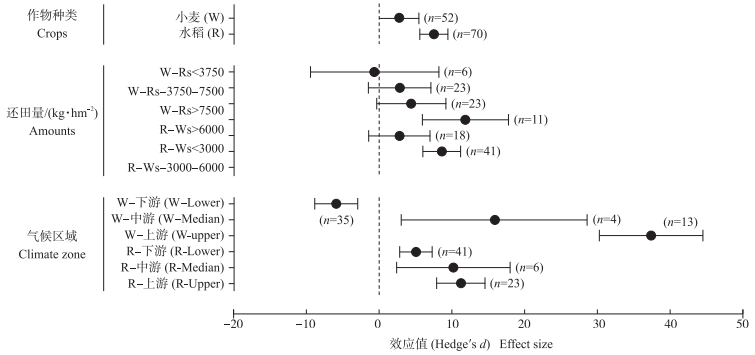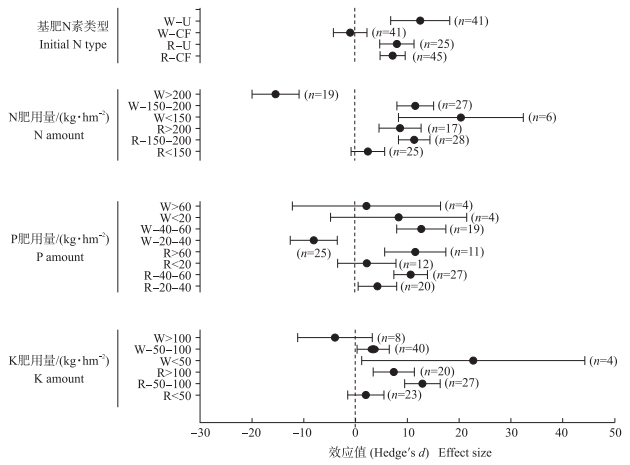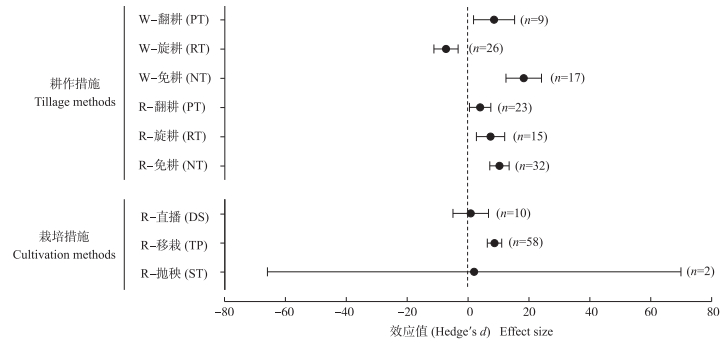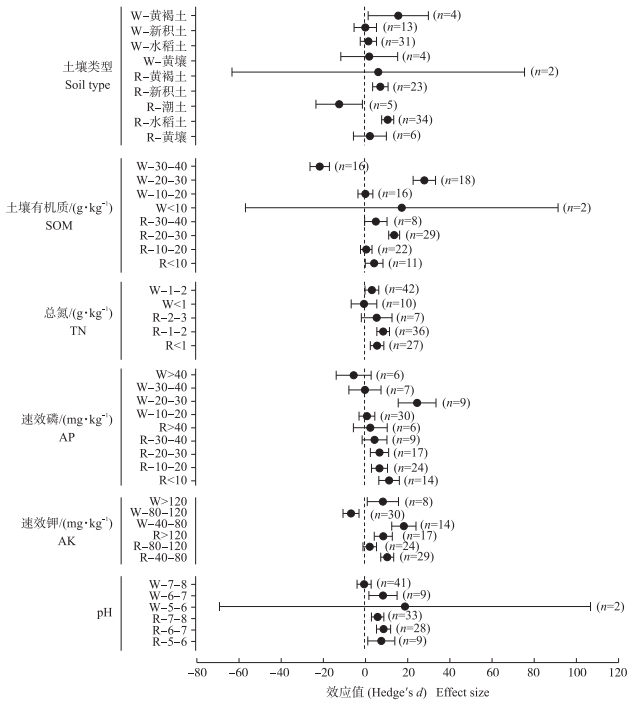文章信息
- 朱冰莹, 马娜娜, 余德贵
- ZHU Bingying, MA Nana, YU Degui
- 稻麦两熟系统产量对秸秆还田的响应:基于Meta分析
- Variation in yield response to straw incorporation in rice-wheat rotation system: Meta-analysis
- 南京农业大学学报, 2017, 40(3): 376-385
- Journal of Nanjing Agricultural University, 2017, 40(3): 376-385.
- http://dx.doi.org/10.7685/jnau.201609036
-
文章历史
- 收稿日期: 2016-09-26
稻麦两熟制是长江流域的主体种植制度[1], 种植面积及产量分别占据全国总耕地面积及粮食总产量的20%以上[2], 对保障全国粮食安全具有重要意义。为保证人口增加和经济快速发展条件下的粮食安全, 水稻、小麦单产还将进一步提高。目前, 除了品种改良与栽培技术优化以外, 稻麦两熟制产量提高主要依赖于高强度化肥、农药的投入[3]。然而, 这种高投入的农业生产体系具有不可持续性, 严重增加了资源消耗和环境污染。面对粮食和生态的双重安全问题, 从长远来看, 亟待开展与稻麦两熟制作物栽培技术相配套的可持续性土壤耕作技术研究, 以充分发挥“良种、良法、良田”的叠加效应。
秸秆还田被认为是一种重要的农业可持续土壤耕作技术[4]。已有大量研究报道了秸秆还田对土壤生态过程的正向调节效应。例如:秸秆还田能够改善土壤结构, 改变土壤水热过程, 引起水分动态和土壤温度的变化[5]; 秸秆还田能够促进真菌菌丝的生长, 通过缠绕较小土壤团粒从而促进团聚化, 并降低土壤容重[6]; 秸秆腐解产生的有机酸能够活化土壤有机磷, 从而提高磷有效性[7]; 秸秆还田能够促进氮素矿化, 并且提高氮素利用效率[8]; 大量秸秆碳源输入土壤刺激微生物大量生长, 从而影响微生物群落组成及功能[9]。
在稻麦两熟制地区, 连年持续少免耕导致犁底层抬升、地力下降, 而秸秆还田可能是保持地力持续供应的最佳途径之一[10]。研究发现, 稻麦两熟制秸秆还田能够有效增加耕层有机质含量, 提高土壤有效养分供应, 改善土壤结构, 降低氮素淋失, 提高作物氮素利用效率[11]。然而, 现有秸秆还田措施也表现出不足之处[12]。例如:秸秆量较大, 实现全量还田难度较大; 还田深度浅, 不利于后续耕种机械行走; 秸秆腐解液抑制后季作物生长; 水稻秸秆输入土壤, 导致小麦种子与土壤接触不实而影响发芽[13]。秸秆输入浅层土壤为土传有害生物的越夏越冬提供良好庇护[14]。因此, 稻麦两熟制现有秸秆还田措施利弊并存, 这可能也是行政措施推行遇阻、秸秆焚烧屡禁不止的重要原因之一。
产量是衡量秸秆还田效益最为重要的指标。在稻麦两熟制地区, 推行秸秆还田对稻麦生产到底有无益处, 目前尚无明确结论。在秸秆还田条件下, 稻麦产量表现为增产[15]、平产[16]和减产[17]均有报道。针对研究结果不一致的情况, 本文采用Meta分析方法对稻麦产量的秸秆还田效益进行定量研究。Meta分析是一种针对同一主题的一系列独立个案研究出现矛盾结论时给予综合定量统计的分析方法[18]。通过对文献公开报道的122项秸秆还田试验结果进行Meta分析, 拟解决以下问题:1) 总体上秸秆还田对稻麦产量到底有无影响, 如果有影响, 是正效应还是负效应; 2) 稻麦产量对秸秆还田的响应程度有无差别; 3) 稻麦产量对秸秆还田的响应受哪些因素影响。
1 材料与方法 1.1 数据来源首先, 以“稻麦两熟或稻麦轮作”和“秸秆还田”为关键词, 对中国知网、维普中文核心期刊数据库和万方数据库分别进行检索, 发表年份限制在1990—2015年, 共检索到204篇文献。其次, 对所检索到的文献进行筛选。筛选条件如下:1) 文献必须报道对照与处理的产量数据; 对照为秸秆不还田, 处理为秸秆还田; 2) 研究结果为大田试验; 3) 研究地点在长江流域, 包括四川、重庆、湖北、安徽、江苏、浙江和上海; 4) 试验处理仅为秸秆还田与否, 不包括使用腐熟剂的试验结果。符合筛选条件的文献共有27篇 (表 1)。我们分别提取了对照和秸秆还田处理下产量的平均值、标准差 (误) 和样本量 (处理重复数)。一般情况下, 文献数据以两种形式呈现:表格和柱状图。对于以表格形式呈现的数据, 直接提取; 对于以柱状图呈现的数据, 用GetData软件 (http://getdata-graph-digitizer.com/) 进行数字化转换。对于仅提供标准误的数据, 我们将其转换为标准差 (SD=SE×sqrt(N))。对于标准差 (误) 缺失的数据, 我们依照van Groenigen等[18]的方法进行估计。方法如下:首先, 计算出整个数据集的变异系数 (variation coefficient, CV); 其次, 以平均值乘以CV来估计缺失的标准差。
| 编号 Code |
试验地点 Site |
土壤类型 Soil type |
基施N肥 N type |
耕作措施 Tillage method |
气候区域 Climatic regions |
参考文献 Reference |
| 1 | 江苏如皋 | 潮土 | 复合肥 | 免耕、旋耕 | 长江下游 | [17] |
| 2 | 江苏常州 | 水稻土 | 复合肥 | 旋耕 | 长江下游 | [19] |
| 3 | 浙江嘉兴 | 水稻土 | 尿素 | 免耕 | 长江下游 | [20] |
| 4 | 湖北潜江 | 水稻土 | 尿素 | 免耕 | 长江中游 | [15] |
| 5 | 江苏扬州 | 新积土 | 复合肥 | 翻耕、免耕 | 长江下游 | [16] |
| 6 | 江苏扬州 | 新积土 | 尿素 | 翻耕 | 长江下游 | [21] |
| 7 | 江苏扬州 | 新积土 | 尿素 | 翻耕 | 长江下游 | [22] |
| 8 | 江苏扬州 | 新积土 | 尿素 | 翻耕 | 长江下游 | [23] |
| 9 | 湖北潜江 | 新积土 | 尿素 | 翻耕 | 长江中游 | [24] |
| 10 | 江苏丹阳 | 黄壤 | 复合肥 | 旋耕 | 长江下游 | [25] |
| 11 | 四川广汉 | 新积土 | 复合肥 | 免耕 | 长江上游 | [26] |
| 12 | 江苏泰州 | 水稻土 | 复合肥 | 旋耕 | 长江下游 | [27] |
| 13 | 江苏扬州 | 新积土 | 复合肥 | 免耕、翻耕 | 长江下游 | [10] |
| 14 | 江苏扬州 | 新积土 | 复合肥 | 旋耕 | 长江下游 | [28] |
| 15 | 江苏淮安 | 潮土 | 复合肥 | 旋耕 | 长江下游 | [29] |
| 16 | 四川成都 | 水稻土 | 复合肥 | 免耕 | 长江上游 | [30] |
| 17 | 四川广汉 | 水稻土 | 复合肥 | 免耕 | 长江上游 | [31] |
| 18 | 江苏无锡 | 黄壤 | 复合肥 | 旋耕 | 长江下游 | [32] |
| 19 | 江苏无锡 | 黄壤 | 复合肥 | 翻耕 | 长江下游 | [33] |
| 20 | 江苏句容 | 水稻土 | 尿素 | 翻耕 | 长江下游 | [34] |
| 21 | 江苏句容 | 水稻土 | 尿素 | 翻耕 | 长江下游 | [35] |
| 22 | 江苏苏州 | 水稻土 | 尿素 | 旋耕 | 长江下游 | [36] |
| 23 | 四川广汉 | 水稻土 | 复合肥 | 免耕、旋耕 | 长江上游 | [37] |
| 24 | 江苏句容 | 水稻土 | 尿素 | 翻耕、免耕 | 长江下游 | [38] |
| 25 | 江苏扬州 | 沙壤土 | 尿素 | 旋耕 | 长江下游 | [39] |
| 26 | 四川简阳 | 黄壤 | 复合肥 | 免耕 | 长江上游 | [40] |
| 27 | 安徽肥东 | 黄褐土 | 尿素 | 旋耕 | 长江中游 | [41] |
首先, 我们总体考虑了两种作物的产量分别对前茬作物秸秆还田的响应程度及其二者之间的差异 (水稻产量对麦秆还田的响应用R表示; 小麦产量对稻秆还田的响应用W表示)。其次, 我们综合考虑了秸秆还田量、施肥措施、土壤类型、栽培措施、耕作措施和气候区域对稻麦产量响应秸秆还田的影响。以小麦秸秆6 000 kg·hm-2和水稻秸秆7 500 kg·hm-2为全量还田标准 (麦秆用WS表示; 稻秆用RS表示), R-WS表示水稻产量对小麦秸秆不同还田量的响应; W-RS表示小麦产量对水稻秸秆不同还田量的响应。依据秸秆还田量将数据分为以下几类:R-WS>6000, 小麦秸秆还田量大于6 000 kg·hm-2; R-WS-3000-6000, 小麦秸秆还田量为3 000~6 000 kg·hm-2; R-WS<3000, 小麦秸秆还田量小于3 000 kg·hm-2; W-RS>7500, 水稻秸秆还田量大于7 500 kg·hm-2; W-RS-3750-7500, 水稻秸秆还田量为3 750~7 500 kg·hm-2; W-RS<3750, 水稻秸秆还田量小于3 750 kg·hm-2。根据气候类型 (长江上游、中游和下游), 将数据分为:W-上游、W-中游、W-下游、R-上游、R-中游、R-下游 (本文也将数据按照研究地点年均降雨量和年均温进行了划分, 并进一步分析, 结果显示, 二者对稻麦产量对秸秆还田的响应并无显著影响, 因此, 未将结果呈现)。对于施肥措施, 我们分别分析了基肥N素类型及全生育期N、P和K肥量。依据基肥N素类型 (复合肥 (CF) 和尿素 (U)) 将数据分为W-CF、W-U、R-CF、R-U。依据全生育期N肥量将数据分为W>200、W-150-200、W<150、R>200、R-150-200、R<150(数据表示N肥用量, 单位为kg·hm-2)。依据全生育期P肥量将数据分为W>60、W-40-60、W-20-40、W<20、R>60、R-40-60、R-20-40、R<20(数据表示P肥用量, 单位为kg·hm-2)。依据全生育期K肥量将数据分为W>100、W-50-100、W<50、R>100、R-50-100、R<50(数据表示K肥用量, 单位为kg·hm-2)。根据栽培措施 (水稻:移栽、直播、抛秧; 小麦全部为直播), 将数据分为W-直播、R-移栽、R-直播、R-抛秧。根据耕作措施 (免耕、旋耕和翻耕) 将数据分为W-免耕、W-旋耕、W-翻耕、R-免耕、R-旋耕、R-翻耕。根据土壤类型 (黄褐土、黄壤、水稻土、潮土、新积土) 将数据分为W-黄褐土、W-黄壤、W-水稻土、W-潮土、W-新积土; R-黄褐土、R-黄壤、R-水稻土、R-潮土、R-新积土。根据土壤有机质 (SOM) 含量, 将数据分为W<10, W-10-20, W-20-30, W-30-40, R<10, R-10-20, R-20-30和R-30-40(数据表示SOM含量, 单位为g·kg-1)。根据土壤总氮 (TN) 含量, 将数据分为W<1, W-1-2, R<1, R-1-2和R-2-3(数据表示土壤TN含量, 单位为g·kg-1)。根据速效磷 (AP) 用量, 将数据分为W-10-20, W-20-30, W-30-40, W>40, R<10, R-10-20, R-20-30和R-30-40(数据表示AP含量, 单位为mg·kg-1)。根据速效钾 (AK) 用量, 将数据分为W-40-80, W-80-120, W>120, R-40-80, R-80-120和R>120(数据表示AK含量, 单位为mg·kg-1)。根据土壤pH值, 将数据分为W-5-6, W-6-7, W-7-8, R-5-6, R-6-7和R-7-8(数据表示pH值)。
1.3 Meta分析选择Hedge′s d来计算效应值 (effect size)。Hedge′s d是对标准化平均差异的估计值, 不受小样本的影响[42]。Hedge′s d计算公式如下[42]:

|
(1) |
式中: XE是秸秆还田处理产量的平均值; XC是对照产量的平均值; S是合并标准差; J为权重因子。J计算公式如下[42]:

|
(2) |
Hedge′s d的方差V(d) 计算公式如下:

|
(3) |
式中:NC为对照重复数; NE为秸秆还田处理重复数。
使用MetaWin 2.0软件对目标数据进行Meta分析[43]。选择随机效应模型进行计算加权平均效应值 (d+)。使用自展法 (bootstrap) 重复抽样9 999次来计算95%置信区间 (confidence interval, CI)。通过95%CI是否包含0, 可以确定研究因子对产量响应的影响是否显著。如果95%CI包含0, 表明影响不显著, 否则影响显著。研究因子之间的差异显著性通过各自95% CI是否重叠来判断。
2 结果与分析从图 1可见:在秸秆还田条件下, 稻麦产量的效应值均显著大于0, 表明秸秆还田显著提高稻麦两熟制作物产量。水稻产量的效应值大于小麦产量, 而且95%CI并不重叠, 表明水稻产量对麦秸还田的响应程度大于小麦产量。

|
图 1 种植作物种类、秸秆还田量及气候区域对稻麦产量响应秸秆还田的影响 Figure 1 Effects of crop species, straw amount and climate zone on the response of wheat/rice yield response to straw incorporation W表示小麦, R表示水稻, W-Rs指小麦产量对不同稻秆还田量的响应, R-Ws表示水稻产量对不同麦秆还田量的响应 (数据表示秸秆还田量)。 W represents wheat, R represents rice, W-Rs represents wheat yield response to different amounts of rice straw incorporation, R-Ws represents rice yield response to different amounts of wheat straw return (the data mean straw return amount). The same as follows. |
在不同还田量条件下, 水稻秸秆还田对小麦产量影响不显著, 但随着水稻秸秆还田量增加, 小麦产量具有增加的趋势; 小麦秸秆还田量在3 000 kg·hm-2以上, 水稻产量显著增加, 但是, 若小麦秸秆还田量低于3 000 kg·hm-2, 则水稻产量不受影响 (图 1)。
不同区域秸秆还田对稻麦产量的影响效果不同 (图 1)。在长江上、中、下游地区, 小麦秸秆还田均显著增加水稻产量; 但是, 水稻秸秆还田仅在长江上、中游地区增加小麦产量, 而在长江下游地区却显著降低小麦产量。
施肥能够显著影响稻麦产量对秸秆还田的响应程度 (图 2)。在稻秸还田条件下, 基肥N肥施用尿素能显著增加小麦产量, 但是, 如果基肥N肥施用复合肥, 则小麦产量不受影响。麦秸还田条件下, 水稻产量不受基肥N肥类型影响。当全生育期N肥施用量小于200 kg·hm-2时, 稻秸还田小麦产量显著增加, 大于200 kg·hm-2时, 小麦产量受到抑制; 而N肥施用量大于150 kg·hm-2时, 麦秸还田水稻产量显著增加, 小于150 kg·hm-2时, 水稻产量增加不明显。当全生育期P肥施用量为40~60 kg·hm-2时, 稻秸还田小麦产量增加最为显著; 而P肥施用量大于40 kg·hm-2时, 麦秸还田水稻产量增加最为显著。当全生育期K肥施用量小于50 kg·hm-2时, 稻秸还田小麦产量显著增加; 而麦秸还田水稻产量显著增加的K肥施用量应大于50 kg·hm-2。

|
图 2 施肥措施对稻麦产量响应秸秆还田的影响 Figure 2 Effects of fertilization on the response of rice/wheat yield to straw return U代表尿素, CF代表复合肥 (数据表示肥料用量)。U represents urea, CF represents compound fertilizer (The data mean fertilizer amount). |
从图 3可见:在稻秸还田下, 翻耕和免耕显著增加小麦产量, 其中, 以免耕表现最佳, 而旋耕显著抑制小麦产量。在麦秸还田下, 免耕、翻耕和旋耕都显著增加水稻产量, 以免耕表现较佳。栽培措施对水稻产量也有一定影响, 麦秸还田条件下, 人工移栽水稻产量显著增加, 而直播对水稻产量影响不显著。

|
图 3 土壤耕作与栽培措施对稻麦产量响应秸秆还田的影响 Figure 3 Response of rice/wheat yield to straw return under different tillage and cultivation methods PT:翻耕Ploughing tillage; RT:旋耕Rotary tillage; NT:免耕No tillage; DS:直播Direct seeding; TP:移栽Transplanting; ST:抛秧Seedling throwing |
土壤类型及理化性状对稻麦产量响应秸秆还田也有一定的影响 (图 4)。在黄壤条件下, 稻秸还田显著增加小麦产量, 而在其他类型土壤, 稻秸还田对小麦产量影响不显著; 麦秸还田下, 水稻产量在新积土和水稻土上显著增加。然而, 在潮土条件下, 麦秸还田显著降低水稻产量。SOM含量在30~40 g·kg-1时, 稻秸还田显著降低小麦产量; 当SOM含量为20~30 g·kg-1时, 稻秸还田显著增加小麦产量; 当SOM含量小于20 g·kg-1时, 稻秸还田对小麦产量影响不显著。TN含量对小麦产量响应稻秸还田的影响不明显; 但是, 当TN小于2 g·kg-1时, 麦秸还田能够显著增加水稻产量。土壤本底AP含量低于30 mg·kg-1时, 秸秆还田能够显著增加稻麦产量; 但AP含量高于30 mg·kg-1时, 秸秆还田的产量效益不明显。AK含量为40~80 mg·kg-1时, 秸秆还田能够较好地增加稻麦产量。土壤pH值对秸秆还田的产量效应影响不显著。

|
图 4 土壤特性对稻麦产量响应秸秆还田的影响 Figure 4 Response of rice/wheat yield to straw return under different soil conditions SOM:土壤有机质Soil organic matter; TN:总氮Total nitrogen; AP:速效磷Available phosphorus; AK:速效钾Available potassium |
研究结果表明, 稻麦两熟制秸秆还田能够显著增加作物产量, 但是, 水稻产量对麦秸还田的响应程度强于小麦产量对稻秸还田的响应程度。稻麦产量对秸秆还田的响应是一个复杂的过程, 受多重因子影响, 包括秸秆还田量、施肥措施、耕作措施及土壤类型等。
3.1 稻麦产量对秸秆还田的响应差异在稻麦两熟区, 秸秆还田确实能够增加作物产量。然而, 水稻产量对麦秸还田的响应显著高于小麦产量对稻秸还田的响应。稻麦产量的响应差异可能由以下几方面因素引起:首先, 土壤环境不同。稻作时, 水分充足, 还田麦秸可能快速腐解; 而麦作时, 水分相对较为缺乏, 水稻秸秆腐解较慢。其次, 秸秆C/N不同。研究发现, 水稻秸秆的C/N高于小麦秸秆, 而C/N高的秸秆腐解速率较快[44]。因此, 在单位时间内, 小麦秸秆腐解能释放出更多氮素供水稻吸收利用。最后, 水稻秸秆腐解产生化感作用。水稻秸秆腐解液中含有较高浓度的酚酸类、萜类和黄酮类化感物质, 对后季小麦的出苗与生长可能产生一定抑制效应[13]。这些因素可能会抵消一部分稻秸还田对小麦产量的正效应。
3.2 还田量还田量是衡量秸秆还田技术的重要指标之一。本研究表明, 小麦秸秆在3 000 kg·hm-2以上, 水稻生产不但安全, 而且产量显著增加。这表明, 在现行生产条件下, 麦秸全量还田是可行的。尽管有人认为稻秸量太大, 全量还田导致土壤空隙太大, 会造成小麦种子与土壤接触不实, 而影响小麦出苗[13], 最终可能会降低小麦产量。然而, 本研究中水稻秸秆全量还田条件下, 小麦产量并未受到影响。
3.3 施肥与耕作秸秆还田必须配合适宜的施肥与耕作措施, 才有可能促使稻麦产量达到最佳。本研究表明, 基肥N素类型和施肥量都会影响稻麦产量对秸秆还田的响应。在稻秸还田时, 基肥N素施以尿素显著增加小麦产量, 但复合肥的效应并不显著。N肥类型并不影响水稻产量对小麦秸秆还田的响应。此外, 肥料用量也需要慎重考虑。虽然前人研究表明, 秸秆还田条件下, 基肥N素用量应该增加, 以减少土壤微生物与作物幼苗竞争N素, 从而造成僵苗[45]。然而, 本研究结果表明, 基肥N素用量需要控制在适宜范围之内。例如, 在稻秸还田时, 如果基施N肥用量超过200 kg·hm-2时, 小麦产量显著降低。P肥与K肥的用量也应控制在合适范围内。磷肥用量在40~60 kg·hm-2的条件下, 水稻和小麦产量均表现出对前茬作物秸秆还田的最大响应; 而磷肥用量超过60 kg·hm-2时, 秸秆还田却对稻麦产量无显著影响。钾肥用量为500~100 kg·hm-2时, 秸秆还田显著增加稻麦产量, 但二者之间存在显著差异。这可能是因为秸秆富含钾素, 全量还田条件下, 稻秸量要多于麦秸量, 因此, 稻秸还田带入土壤的钾素要多于麦秸还田。
土壤耕作措施对秸秆还田具有显著影响。本研究结果表明, 在旋耕条件下, 稻秸还田小麦产量显著降低, 而免耕显著增加小麦产量。可能原因如下:旋耕深度太浅, 将粉碎的水稻秸秆大量集中于耕层土壤, 而水稻秸秆具有较高的碳氮比并且能够产生化感物质, 这可能直接导致微生物与麦苗争氮, 化感作用影响小麦的出苗立苗, 进而造成减产[45-46]。这也可能是长江下游区域秸秆还田降低小麦产量的主要原因之一。因此, 在稻麦两熟区, 应该探索新的秸秆还田方式, 例如秸秆集中沟埋或秸秆深还等, 将秸秆掩埋于耕作层以下, 使得秸秆与根系在空间上暂时隔离, 从而降低化感抑制或微生物氮素竞争等效应。
3.4 土壤本底条件前人研究很少关注土壤本底条件对秸秆还田效应的影响。然而, 本研究表明, 土壤理化性状, 特别是有机质和速效钾对稻麦产量响应前茬作物秸秆还田的影响较大。在有机质含量较高 (30~40 g·kg-1) 的土壤, 稻秸还田显著降低了小麦产量, 而在中等水平有机质含量 (20~30 g·kg-1) 土壤, 稻秸还田显著促进了小麦产量。可能原因如下:在有机质含量较高的土壤, 大量外源水稻秸秆的输入, 一方面可能会激发微生物的生长而降低小麦生长所需的有效氮素[45]; 另一方面, 可能导致土壤过于松软, 造成小麦立苗困难、易于倒伏。在速效钾含量较低 (40~80 mg·kg-1) 的土壤, 秸秆还田的产量效益较高, 而在速效钾含量较高的土壤, 秸秆还田效应不明显, 甚至出现负效应。这可能是由于秸秆腐解会释放出大量钾素。在钾素含量较低的土壤, 秸秆腐解释放的钾素, 刚好可以维持土壤钾素平衡, 以保证作物生长。然而, 在钾素含量较高的土壤, 秸秆腐解释放钾素会进一步导致土壤钾素含量过高, 而可能抑制作物对其他营养元素的吸收利用[47]。
尽管本文从近20年历史资料角度, 通过Meta分析方法, 定量分析了稻麦产量对秸秆还田的响应, 并综合分析了还田量、耕作与栽培措施等因素, 但是, 本研究依然存在以下不足:
首先, 数据来源主要集中在长江下游地区, 而长江中、上游地区资料来源较少, 甚至来源于同一课题组。尽管研究结果显示不同区域的稻麦产量对秸秆还田的响应差异显著, 但是, 这一结论是否由不同区域农业气候资源因子造成, 还需进一步深入研究。
其次, 有些因子的样本量不足, 难以下结论。例如, 在潮土麦秸还田下, 水稻产量降低。由于该因子的5个样本仅来源于一篇文献, 因此, 不能断定潮土类型是否影响水稻产量对麦秸还田的响应。
| [1] |
杨建昌, 杜永, 刘辉. 长江下游稻麦周年超高产栽培途径与技术[J].
中国农业科学, 2008, 41(6): 1611–1621.
Yang J C, Du Y, Liu H. Cultivation approaches and techniques for annual super-high-yielding of rice and wheat in the lower reaches of Yangtze River[J]. Scientia Agricultura Sinica, 2008, 41(6): 1611–1621. (in Chinese) |
| [2] |
中国农业年鉴编辑委员会.
中国农业年鉴——2011[M]. 北京: 中国农业出版社, 2012: 1-593.
Editorial Board of China Agriculture Yearbook. China Agricultural Yearbook:2011[M]. Beijing: China Agriculture Press, 2012: 1-593. (in Chinese) |
| [3] | Yang H, Yang B, Dai Y J, et al. Soil nitrogen retention is increased by ditch-buried straw return in a rice-wheat rotation system[J]. European Journal of Agronomy, 2015, 69: 52–58. DOI: 10.1016/j.eja.2015.05.005 |
| [4] |
杜康, 谢源泉, 林赵淼, 等. 秸秆还田条件下氮肥对水稻幼苗生长及养分吸收的影响[J].
南京农业大学学报, 2016, 39(1): 18–25.
Du K, Xie Y Q, Lin Z M, et al. Effect of nitrogen on rice seedling growth and nutrient uptake under wheat straw returning[J]. Journal of Nanjing Agricultural University, 2016, 39(1): 18–25. DOI: 10.7685/jnau.201503034 (in Chinese) |
| [5] | Lenka N K, Lal R. Soil aggregation and greenhouse gas flux after 15 years of wheat straw and fertilizer management in a no-till system[J]. Soil and Tillage Research, 2013, 126: 78–89. DOI: 10.1016/j.still.2012.08.011 |
| [6] | Peng S L, Guo T, Liu G C. The effects of arbuscular mycorrhizal hyphal networks on soil aggregations of purple soil in southwest China[J]. Soil Biology and Biochemistry, 2013, 57: 411–417. DOI: 10.1016/j.soilbio.2012.10.026 |
| [7] | Shan Y H, Cai Z C, Han Y, et al. Organic acid accumulation under flooded soil conditions in relation to the incorporation of wheat and rice straws with different C:N ratios[J]. Soil Science and Plant Nutrition, 2008, 54(1): 46–56. DOI: 10.1111/j.1747-0765.2007.00218.x |
| [8] |
潘剑玲, 代万安, 尚占环, 等. 秸秆还田对土壤有机质和氮素有效性影响及机制研究进展[J].
中国生态农业学报, 2013, 21(5): 526–535.
Pan J L, Dai W A, Shang Z H, et al. Review of research progress on the influence and mechanism of field straw residue incorporation on soil organic matter and nitrogen availability[J]. Chinese Journal of Eco-Agriculture, 2013, 21(5): 526–535. (in Chinese) |
| [9] | Zhao Y G, Pang H C, Wang J, et al. Effects of straw mulch and buried straw on soil moisture and salinity in relation to sunflower growth and yield[J]. Field Crops Research, 2014, 161: 16–25. DOI: 10.1016/j.fcr.2014.02.006 |
| [10] |
刘世平, 聂新涛, 张洪程, 等. 稻麦两熟条件下不同土壤耕作方式与秸秆还田效用分析[J].
农业工程学报, 2006, 22(7): 48–51.
Liu S P, Nie X T, Zhang H C, et al. Effects of tillage and straw returning on soil fertility and grain yield in a wheat-rice double cropping system[J]. Transactions of the Chinese Society of Agricultural Engineering, 2006, 22(7): 48–51. (in Chinese) |
| [11] |
曾洪玉, 唐宝国, 蔡建华, 等. 秸秆还田对耕地质量及稻麦产量的影响[J].
江苏农业科学, 2011, 39(4): 499–501.
Zeng H Y, Tang B G, Cai J H, et al. Effects of straw incorporation on soil quality and rice/wheat yield[J]. Jiangsu Agricultural Sciences, 2011, 39(4): 499–501. (in Chinese) |
| [12] |
常志州, 王德建, 杨四军, 等. 对稻麦秸秆还田问题的思考[J].
江苏农业学报, 2014, 30(2): 304–309.
Chang Z Z, Wang D J, Yang S J, et al. Thoughts on returning straw to field[J]. Jiangsu Journal of Agricultural Sciences, 2014, 30(2): 304–309. (in Chinese) |
| [13] |
于建光, 顾元, 常志州, 等. 小麦秸秆浸提液和腐解液对水稻的化感效应[J].
土壤学报, 2013, 50(2): 349–356.
Yu J G, Gu Y, Chang Z Z, et al. Allelopathic effects of wheat straw extract and decomposition liquid on rice[J]. Acta Pedologica Sinica, 2013, 50(2): 349–356. DOI: 10.11766/trxb201206150234 (in Chinese) |
| [14] |
孙秀娟, 李妍, 朱利群, 等. 秸秆集中掩埋还田深度对二化螟幼虫越冬存活率和出土规律的影响[J].
江苏农业学报, 2012, 28(4): 743–747.
Sun X J, Li Y, Zhu L Q, et al. Effects of burial depth of straw returned to soil on survival rate and emergence behavior of Chilo suppressalis over-wintering larva[J]. Jiangsu Journal of Agricultural Sciences, 2012, 28(4): 743–747. (in Chinese) |
| [15] |
李继福, 鲁剑巍, 李小坤, 等. 麦秆还田配施不同腐秆剂对水稻产量、秸秆腐解和土壤养分的影响[J].
中国农学通报, 2013, 29(35): 270–276.
Li J F, Lu J W, Li X K, et al. Effect of wheat straw returning with different organic matter-decomposing inoculants (OMIS) on the yield of rice, the decomposition of straw and soil nutrients[J]. Chinese Agricultural Science Bulletin, 2013, 29(35): 270–276. DOI: 10.11924/j.issn.1000-6850.2013-0449 (in Chinese) |
| [16] |
刘世平, 聂新涛, 戴其根, 等. 免耕套种与秸秆还田对水稻生长和稻米品质的影响[J].
中国水稻科学, 2007, 21(1): 71–76.
Liu S P, Nie X T, Dai Q G, et al. Effects of interplanting with zero tillage and wheat straw manuring on rice growth and grain quality[J]. Chinese Journal of Rice Science, 2007, 21(1): 71–76. (in Chinese) |
| [17] |
朱利群, 张大伟, 卞新民. 连续秸秆还田与耕作方式轮换对稻麦轮作田土壤理化性状变化及水稻产量构成的影响[J].
土壤通报, 2011, 42(1): 81–85.
Zhu L Q, Zhang D W, Bian X M. Effects of continuous returning straws to field and shifting different tillage methods on changes of physical-chemical properties of soil and yield components of rice[J]. Chinese Journal of Soil Science, 2011, 42(1): 81–85. (in Chinese) |
| [18] | van Groenigen K J, Osenberg C W, Hungate B A. Increased soil emissions of potent greenhouse gases under increased atmospheric CO2[J]. Nature, 2011, 475(7355): 214–216. DOI: 10.1038/nature10176 |
| [19] |
李克, 李想, 李宗岭. 连云港市秸秆全量还田条耕条播技术试验研究与分析[J].
农业装备技术, 2014, 40(2): 17–19.
Li K, Li X, Li Z L. Study and analysis of straw incorporation with ploughing and sowing in line in Lianyungang City[J]. Agricultural Equipment and Technology, 2014, 40(2): 17–19. (in Chinese) |
| [20] |
钟杭, 张勇勇, 林潮澜, 等. 麦稻秸秆全量整草免耕还田方法和效果[J].
土壤肥料, 2003(3): 34–37.
Zhong H, Zhang Y Y, Lin C L, et al. A method of full amount of rice/wheat straw incorporation and its effects[J]. Soils and Fertilizers, 2003(3): 34–37. (in Chinese) |
| [21] |
聂新涛. 免耕与秸秆还田对农田生态环境和稻麦生产力的影响[D]. 扬州: 扬州大学, 2007.
Nie X T. Effects of no-till and straw incorporation on field eco-environments and rice/wheat yield[D]. Yangzhou:Yangzhou University, 2007(in Chinese with English abstract). |
| [22] |
戴锋平. 免耕与秸秆还田对土壤理化性质和小麦生长的影响[D]. 扬州: 扬州大学, 2013.
Dai F P. Effects of no-till and straw incorporation on soil physicochemical properties and wheat growth[D]. Yangzhou:Yangzhou University, 2013(in Chinese with English abstract). |
| [23] |
刘萌. 全量还田麦秸秆腐解特征及对土壤理化性质和水稻产量形成的影响[D]. 扬州: 扬州大学, 2012.
Liu M. Decay characteristics of wheat straw incorporation with full amounts and its effects on soil physicochemical properties and rice yield[D]. Yangzhou:Yangzhou University, 2012(in Chinese with English abstract). |
| [24] |
丁亨虎, 吴家琼, 刘克芝, 等. 小麦秸秆不同还田量对中稻生长发育及产量的影响[J].
现代农业科技, 2013(24): 233–236, 239.
Ding H H, Wu J Q, Liu K Z, et al. Effects of wheat straw return with different amounts on semilate rice growth and yield[J]. Modern Agricultural Science and Technology, 2013(24): 233–236, 239. DOI: 10.3969/j.issn.1007-5739.2013.24.150 (in Chinese) |
| [25] |
张永春, 汪吉东, 聂国书, 等. 不同量秸秆机械化还田对稻麦产量及土壤碳活性的影响[J].
江苏农业学报, 2008, 24(6): 833–838.
Zhang Y C, Wang J D, Nie G S, et al. Effects of mechanized straw incorporation with different amounts on rice/wheat yield and soil enzymatic activity[J]. Jiangsu Journal of Agricultural Sciences, 2008, 24(6): 833–838. (in Chinese) |
| [26] |
李朝苏, 汤永禄, 吴春, 等. 稻草还田方式及还田量对稻茬小麦播种立苗质量和产量建成的影响[J].
西南农业学报, 2014, 27(3): 996–1002.
Li C S, Tang Y L, Wu C, et al. Effect of rice straw returning pattern and mulching amount on mechanical sowing quality and yield formation of wheat[J]. Southwest China Journal of Agricultural Sciences, 2014, 27(3): 996–1002. (in Chinese) |
| [27] |
李亚伟, 刘俊, 黄奇. 稻麦连作模式下稻秸不同还田方式和还田量对小麦的影响[J].
现代农业科技, 2014(8): 23–26, 29.
Li Y W, Liu J, Huang Q. Effects of different incorporating methods and amounts of rice straw on wheat yield in a rice-wheat rotation system[J]. Modern Agricultural Science and Technology, 2014(8): 23–26, 29. (in Chinese) |
| [28] |
韩新忠. 稻麦轮作条件下秸秆还田对作物、土壤微生物及碳库的影响[D]. 南京: 南京农业大学, 2013.
Han X Z. Effects of straw incorporation on crops, soil microbes and carbon pool in a rice-wheat rotation system[D]. Nanjing:Nanjing Agricultural University, 2013(in Chinese with English abstract). |
| [29] |
颜建东, 宋佳兴, 吴川. 秸秆腐熟剂对麦秸的腐熟作用及对水稻的增产效应[J].
农技服务, 2014, 31(3): 64.
Yan J D, Song J X, Wu C. Effects of microbial inoculants on straw decomposition and rice yield[J]. Agricultural Technology Service, 2014, 31(3): 64. (in Chinese) |
| [30] |
严洁, 邓良基, 黄剑. 保护性耕作对土壤理化性质和作物产量的影响[J].
中国农机化, 2005, 26(2): 31–34.
Yan J, Deng L J, Huang J. Effects of conservation tillage on soil physicochemical properties and crop yields[J]. Chinese Agricultural Mechanization, 2005, 26(2): 31–34. (in Chinese) |
| [31] |
王克如, 李少昆, 汤永禄, 等. 成都平原免耕及不同麦秸还田量种植水稻的研究[J].
水土保持学报, 2006, 20(5): 171–174.
Wang K R, Li S K, Tang Y L, et al. Research on rice cultivation under no-tillage with different straw weight of wheat return field in Chengdu plain[J]. Journal of Soil and Water Conservation, 2006, 20(5): 171–174. (in Chinese) |
| [32] |
刘红江, 陈留根, 朱普平, 等. 稻草还田对小麦产量、地表径流NPK流失量及土壤肥力的影响[J].
水土保持学报, 2010, 24(6): 6–10.
Liu H J, Chen L G, Zhu P P, et al. Effects of rice straw return on wheat yield, overland runoff NPK loss and soil fertility[J]. Journal of Soil and Water Conservation, 2010, 24(6): 6–10. (in Chinese) |
| [33] |
刘红江, 陈留根, 周炜, 等. 麦秸还田对水稻产量及地表径流NPK流失的影响[J].
农业环境科学学报, 2011, 30(7): 1337–1343.
Liu H J, Chen L G, Zhou W, et al. Effects of wheat straw return on rice yield and the NPK loss with overland runoff[J]. Journal of Agro-Environment Science, 2011, 30(7): 1337–1343. (in Chinese) |
| [34] |
马二登, 马静, 徐华, 等. 稻秆还田方式对麦田N2O排放的影响[J].
土壤, 2007, 39(6): 870–873.
Ma E D, Ma J, Xu H, et al. Effects of rice straw returning methods on N2O emissions from wheat-growing season[J]. Soils, 2007, 39(6): 870–873. (in Chinese) |
| [35] |
马二登, 马静, 徐华, 等. 麦季稻秆还田方式对后续稻季CH4排放的影响[J].
生态环境学报, 2010, 19(3): 729–732.
Ma E D, Ma J, Xu H, et al. Effects of rice straw returning methods in wheat-growing season on CH4 emissions from following rice-growing season[J]. Ecology and Environmental Sciences, 2010, 19(3): 729–732. (in Chinese) |
| [36] |
王振忠, 吴敬民, 陈留根, 等. 稻麦两熟地区秸秆全量直接还田施肥技术的增产培肥效果[J].
江苏农业学报, 2003, 19(3): 151–156.
Wang Z Z, Wu J M, Chen L G, et al. Effects of direct and whole straw manuring method on increasing yield of crop and fertility of soil in rice-wheat double cropping area of Taihu Lake district[J]. Jiangsu Journal of Agricultural Sciences, 2003, 19(3): 151–156. (in Chinese) |
| [37] |
李朝苏, 王克如, 谢瑞芝, 等. 稻麦轮作区麦秸还田对水稻产量及主要品质性状的影响[J].
西南农业学报, 2009, 22(4): 895–900.
Li C S, Wang K R, Xie R Z, et al. Effects of wheat residue retention on grain yield and main quality characters of rice-wheat cropping system[J]. Southwest China Journal of Agricultural Science, 2009, 22(4): 895–900. (in Chinese) |
| [38] |
马静, 徐华, 蔡祖聪, 等. 秸秆条带状覆盖对稻田CH4和N2O排放的影响[J].
土壤学报, 2010, 47(1): 84–89.
Ma J, Xu H, Cai Z C, et al. CH4 and N2O emissions from rice fields as affected by mulching of strips of wheat straws[J]. Acta Pedologica Sinica, 2010, 47(1): 84–89. DOI: 10.11766/trxb2010470113 (in Chinese) |
| [39] |
张洪熙, 戴正元, 陈秀兰, 等. 麦草还田直播水稻扬辐粳8号的生长发育特性[J].
江苏农业科学, 2007, 35(1): 4–7.
Zhang H X, Dai Z Y, Chen X L, et al. Growth characteristics of direct-seeding rice Yangfujing 8 under wheat straw incorporation[J]. Jiangsu Agricultural Sciences, 2007, 35(1): 4–7. (in Chinese) |
| [40] |
郑家国, 谢红梅, 姜心禄, 等. 南方丘区两熟制稻田保护性耕作的稻田生态效应[J].
农业现代化研究, 2005, 26(4): 294–297.
Zheng J G, Xie H M, Jiang X L, et al. Ecological effect on paddy field under two ripe system conserve cultivation of hilly region in southward of China[J]. Research of Agricultural Modernization, 2005, 26(4): 294–297. (in Chinese) |
| [41] |
武际, 郭熙盛, 鲁剑巍, 等. 水旱轮作制下连续秸秆覆盖对土壤理化性质和作物产量的影响[J].
植物营养与肥料学报, 2012, 18(3): 587–594.
Wu J, Guo X S, Lu J W, et al. Effects of continuous straw mulching on soil physical and chemical properties and crop yields in paddy-upland rotation system[J]. Plant Nutrition and Fertilizer Science, 2012, 18(3): 587–594. DOI: 10.11674/zwyf.2012.11304 (in Chinese) |
| [42] | Hedges L V, Olkin I. Statistical Methods for Meta-Analysis[M]. New York: Academic Press, 1985. |
| [43] | Rosenberg M S, Adams D C, Gurevitch J. MetaWin:Statistical Software for Meta-analysis (Version 2.0)[M]. Sunderland, MA: Sinauer Associated Inc. Publishers, 2000. |
| [44] |
王德建, 常志州, 王灿, 等. 稻麦秸秆全量还田的产量与环境效应及其调控[J].
中国生态农业学报, 2015, 23(9): 1073–1082.
Wang D J, Chang Z Z, Wang C, et al. Regulation and effect of 100% straw return on crop yield and environment[J]. Chinese Journal of Eco-Agriculture, 2015, 23(9): 1073–1082. (in Chinese) |
| [45] |
张维乐, 戴志刚, 任涛, 等. 不同水旱轮作体系秸秆还田与氮肥运筹对作物产量及养分吸收利用的影响[J].
中国农业科学, 2016, 49(7): 1254–1266.
Zhang W L, Dai Z G, Ren T, et al. Effects of nitrogen fertilization managements with residues incorporation on crops yield and nutrients uptake under different paddy-upland rotation systems[J]. Scientia Agricultura Sinica, 2016, 49(7): 1254–1266. DOI: 10.3864/j.issn.0578-1752.2016.07.004 (in Chinese) |
| [46] |
李静, 淘宝瑞, 焦美玲, 等. 秸秆还田下我国南方稻田表土固碳潜力研究——基于Meta分析[J].
南京农业大学学报, 2015, 38(3): 351–359.
Li J, Tao B R, Jiao M L, et al. Assessment on topsoil carbon sequestration potential under straw return modes in paddy fields in South China:based on a Meta-analysis[J]. Journal of Nanjing Agricultural University, 2015, 38(3): 351–359. DOI: 10.7685/j.issn.1000-2030.2015.03.001 (in Chinese) |
| [47] |
齐红岩, 李天来, 富宏丹, 等. 不同氮钾施用水平对番茄营养吸收和土壤养分变化的影响[J].
土壤通报, 2006, 37(2): 268–272.
Qi H Y, Li T L, Fu H D, et al. Effects of different rates of nitrogen and potassium on nutrient levels in tomato and soil[J]. Chinese Journal of Soil Science, 2006, 37(2): 268–272. (in Chinese) |




